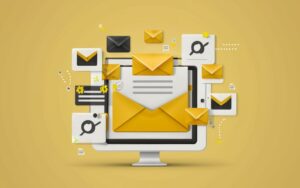Imagine this: you've just received an important email at work, and you've got only a few minutes to respond before heading into a meeting. Reaching for your phone, you furiously swipe and tap, yet frustratingly, you cannot locate your inbox. This scenario is all too common and begs the question: "Where is my inbox on my phone?" With the myriad of email applications available and the continued evolution of smartphone operating systems, navigating your device can become surprisingly complicated.
You’ll learn:
- Different email apps and how they organize inboxes
- Step-by-step guidance for popular apps: Gmail, Outlook, and Apple Mail
- Common troubleshooting tips for finding your inbox
- Comparison of email apps for ease of access
- Frequently Asked Questions to clear lingering doubts
Navigating Popular Email Apps
Email has revolutionized how we communicate, making it imperative to know exactly where your inbox resides on your phone. Let's dive into the most used email apps and how to find your inbox in each.
Gmail
Gmail, one of the world's most popular email services, provides users with a seamless experience on both Android and iOS devices. But where is my inbox on my phone when using Gmail?
-
Download and Install: First, ensure that the Gmail app is downloaded and installed from the Google Play Store or Apple App Store.
-
Open the App: Upon opening the app, you will usually land directly on your Primary inbox, characterized by a minimalist design that prioritizes your most important messages.
-
Navigate Through Tabs: Gmail segments emails into different tabs like Promotions, Social, and Updates. Swipe left or right at the top to switch between these sections.
-
Use the Sidebar Menu: To access other folders or jump between multiple accounts, tap on the three horizontal lines (hamburger icon) in the upper-left corner.
Outlook
With Outlook, a Microsoft product, finding your inbox on a phone is slightly different and tailored for seamless integration with Windows services.
-
Installation: Download from either the Play Store or App Store and sign in with your email credentials.
-
Inbox Identification: Your emails will appear on the main screen upon logging in, categorized as Focused or Other. These filters are designed to show important messages first.
-
Navigating the Interface: Use the bottom bar to switch between Mail, Search, and Calendar. The app’s intuitive design keeps the inbox centrally accessible.
-
Customization Options: Organize your inbox using the customizable settings under the gear icon to better fit your workflow.
Apple Mail
For users immersed in the Apple ecosystem, Apple Mail naturally integrates with their devices. The process of finding your inbox on your iPhone is straightforward:
-
Pre-installed App: Apple Mail is built into every iPhone. Open the app directly from the home screen.
-
Accessing the Inbox: By default, the app places you in the unified inbox view, if you have multiple accounts linked.
-
Managing Multiple Accounts: Tap on the Mailboxes link at the top left to switch between accounts or access individual folders like Sent or Junk.
-
Notifications and Alerts: Ensure settings allow notifications for incoming mail to remain promptly informed.
Troubleshooting Tips
If you still find yourself asking, "Where is my inbox on my phone?" consider the following troubleshooting tips:
-
Ensuring Sync Settings: Often, syncing settings might prevent emails from showing up instantly. Check your app’s syncing settings and ensure they are set to 'automatic.'
-
App Update: Ensure all your email apps are updated to the latest version, as developers often release improvements and bug fixes.
-
Check Connectivity: A stable internet connection is necessary for the proper functioning of any email app. Make sure your Wi-Fi or data connection is active.
-
Reinstallation: As a last resort, uninstall and reinstall the app in question. This refresh can sometimes resolve underlying issues.
Comparison of Email Apps
When deciding on an email service, consider the ease of locating your inbox as a crucial feature. Here’s a quick comparison:
- Gmail: Best for Google service integration and robust organization tools.
- Outlook: Ideal for those using Microsoft Office products, emphasizing productivity.
- Apple Mail: Best suited for Apple device users seeking seamless integration.
Each app has its own strengths and caters to different needs, so choose one that aligns best with your personal and professional workflow.
FAQ
1. Can I customize the appearance of my inbox on my phone?
Yes, most email apps allow some level of customization, such as changing themes, adjusting notification settings, and filtering which emails are highlighted.
2. Why can't I find certain emails in my inbox?
Emails might not be visible due to filters or labels pushing them to other tabs like Promotions or Spam. Check these folders if an expected email is not in your primary inbox.
3. What should I do if my phone isn’t syncing emails properly?
Ensure that the sync is enabled in your app settings. Check your device’s background data settings if your emails aren’t automatically updating.
4. How can I access multiple email accounts from one app?
Most modern email apps support multiple accounts. Look for an 'Add Account' option within the app’s settings. This allows for a unified view of all your emails.
Summary
- Popular Apps: Navigate Gmail, Outlook, and Apple Mail to locate your inbox.
- Sync Settings: Ensure syncing is on to avoid missing emails.
- App Comparison: Choose an app based on your specific integration needs.
- Customization: Modify how your inbox looks and notifies based on personal preferences.
If understanding "Where is my inbox on my phone?" seemed daunting, this guide simplifies the search. By following these detailed instructions and tips, you should navigate the digital maze of emails with newfound confidence.



